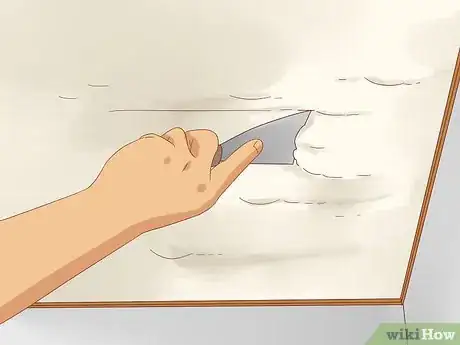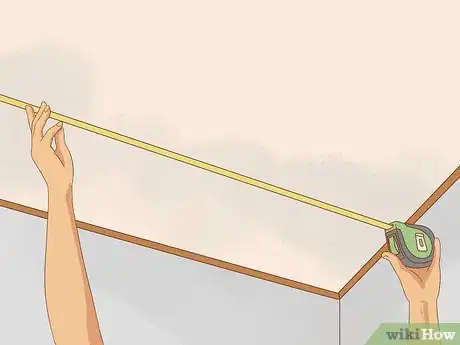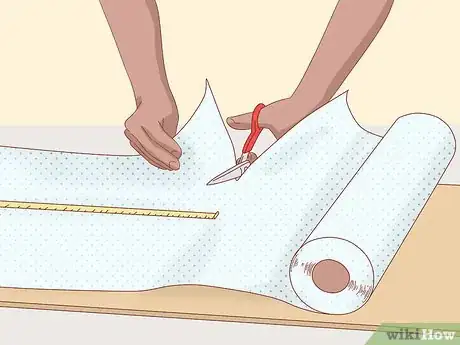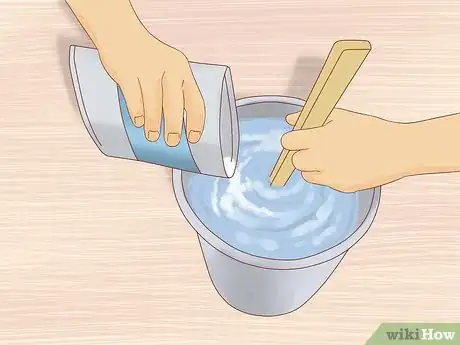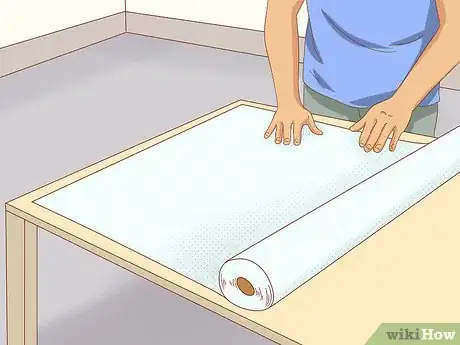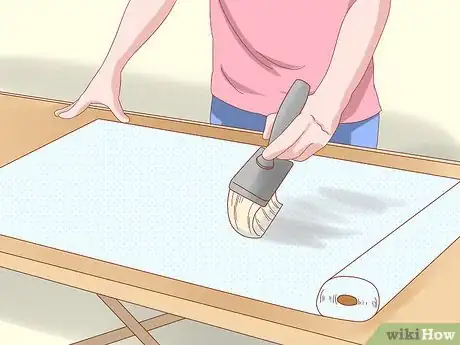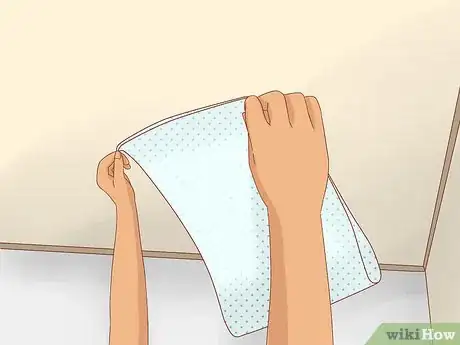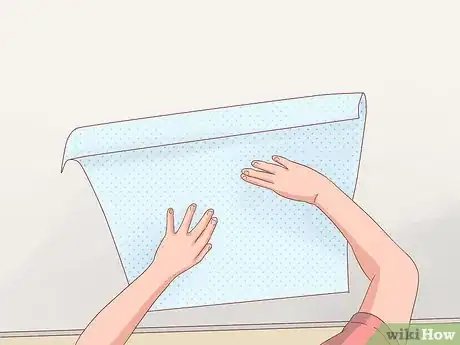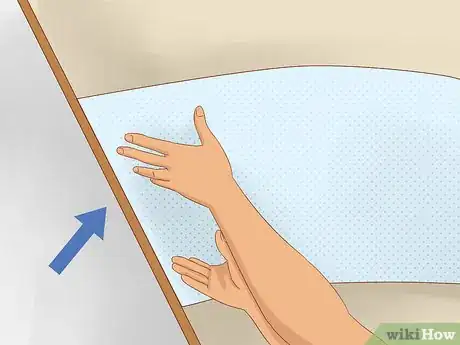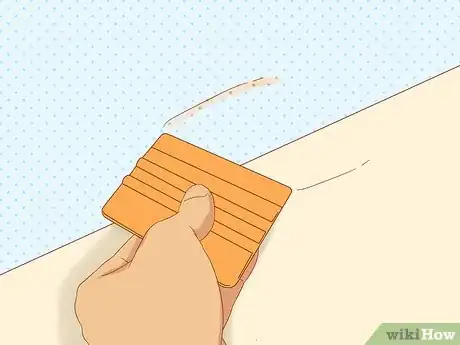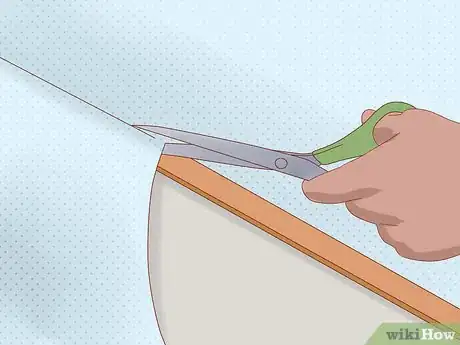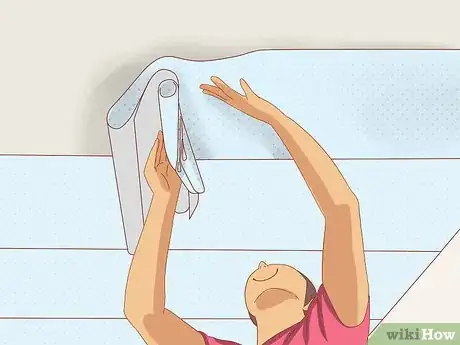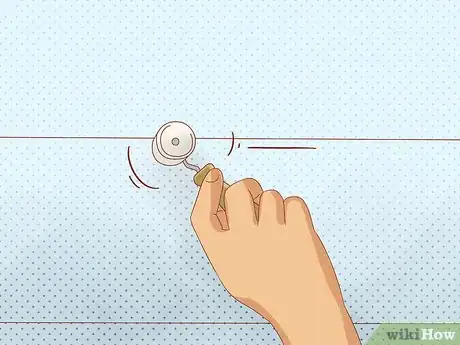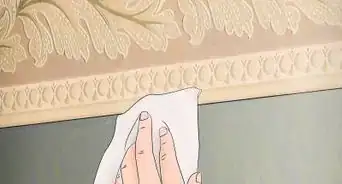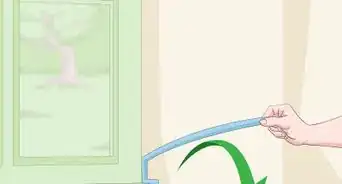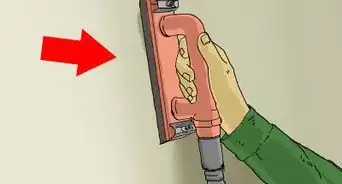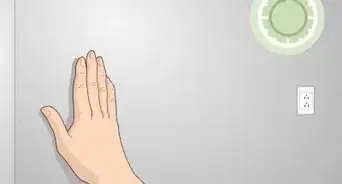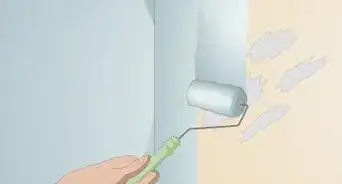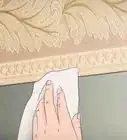This article was co-authored by Katherine Tlapa. Katherine Tlapa is an interior designer, currently working as a Design Specialist for Modsy, a design service based in San Francisco. She also runs her own DIY Home Design blog, My Eclectic Grace. She received her BFA in Interior Architecture from Ohio University in 2016.
There are 8 references cited in this article, which can be found at the bottom of the page.
This article has been viewed 95,373 times.
Hanging wallpaper is a an easy, popular way to decorate your home. Typically, wallpaper is applied to the walls, but hanging wallpaper on the ceiling is growing more and more popular. You can wallpaper your ceiling to match the wallpaper on your walls, or you can wallpaper the ceiling exclusively to create a unique look. Apply paste to the back of your wallpaper for a secure hold, and smooth it onto the ceiling with a plastic applicator tool. Grab a friend to help, and you can easily wallpaper your ceiling.
Steps
Preparing Your Ceiling and Wallpaper
-
1Cover your floor with plastic drop cloths or dust covers. To protect your floors from any dust, debris, or paste, stretch a plastic covering across the floor. This way, there will be less cleanup when you are finished. If you have a ceiling fan or large light fixture, you can also gently wrap it in a plastic covering.[1]
-
2Scrape off any flaky paint and sand any rough areas of the ceiling. Put on safety goggles and use a ladder to reach the ceiling. Gently glide a paint scraper across your ceiling to get rid of any old, flaky remnants. If there are rough spots or uneven edges, use 80- to 120-grit sandpaper to smooth the surface.[2]
- This will depend on your particular ceiling. If your ceiling is smooth and clean, you may apply the wallpaper without any preparation.
Advertisement -
3Measure your ceiling to determine how much wallpaper you need. Use a measuring tape to figure out the length and width of your room. Measure to the nearest inch or centimeter, then add about 1 in (2.5 cm) to account for the edges. Then, purchase wallpaper large enough to cover the measured area.[3]
- You can purchase your wallpaper on a roll. The rolls are usually 11 yd (10 m) in length.
-
4Cut the wallpaper to the size of your ceiling measurements. After purchasing wallpaper, use your measuring tape to indicate how many pieces you need to cut. Then, cut your wallpaper using a sharp pair of scissors.[4]
- It is okay if your measurements aren’t perfect; however, always round up rather than round down. This way, you can trim off any extra, rather than having your wallpaper be too short.
Mixing the Paste
-
1Read the instructions on the mix-it-yourself wallpaper paste. To ensure a thorough hold, use wallpaper paste on your ceiling. Purchase mix-it-yourself paste from a home supply store. Then, read through the directions thoroughly so you correctly apply your particular mix.[5]
-
2Mix the paste in a large bucket following the instructions. Each mix is slightly different, but in general, mix it with water following the outlined ratios. Then, use a paint mixer to blend the powder and water into a paste. Continue mixing the concoction until it is smooth and not runny.[6]
- It should take several minutes to thoroughly mix up the paste.
-
3Set up a table you can use to apply the wallpaper with paste. Place a folding table in the middle of the room, and put your pieces of wallpaper on top. Then, pour the paste into a paint tray.[7]
Hanging the Wallpaper
-
1Apply the paste to your wallpaper from the middle to the sides. For a thorough application, paint the paste onto the wallpaper with a 1–2 in (2.5–5.1 cm) brush or a 7–12 in (18–30 cm) paint roller. Use a generous, even coat of paste so your wallpaper sticks securely.
- Starting from the middle helps spread the paste across the paper, so it does not get too concentrated in the center.
-
2Move the sheet closer to the ceiling by bringing the wet sides together. To transport your sheet of wallpaper to the ceiling, it is best to face both paste sides together, rather than bringing 1 side with paste to the opposite side. To do this, hold 1 side of the wallpaper and have a friend hold the other side. Then, move the sheet slowly toward the center. Ensure the paste is facing upwards when you do this.[8]
- If you have a very long strip of wallpaper, you can alternate your folds in order to neatly condense the whole strip.
-
3Start at the widest part of your ceiling. This makes it easier hang the wallpaper. Place the first wallpaper sheet approximately in the center of your ceiling. This way, you are covering the widest part if your room starts to taper or change in size. To do this, use a ladder to help you reach the ceiling.[9]
- While this is recommended, it is not required.
-
4Stick the edge of the wallpaper, where your ceiling meets the wall. Ensure the wallpaper is paste-side up, and line up the edge of the wallpaper to the edge of your ceiling. Use your hand to smooth over the center.[10]
- In addition to your hand, you can use a plastic applicator to smooth the wallpaper into place.
-
5Make a cut in the wallpaper if you are hanging it around fixtures. Before you secure all of the wallpaper to the ceiling, stop right before you reach a fixture, like a light fixture. Use your scissors to cut around the fixture so the wallpaper is the appropriate size. If cutting in a circle, you can make small snips vertically in a circle every 1⁄2 in (1.3 cm), then cut them all off with 1 horizontal snip. Then, continue to smooth the rest of the wallpaper across your ceiling.[11]
- Be careful when cutting around the fixture. You don’t want to hurt yourself or damage the fixture.
-
6Rub your plastic applicator over the wallpaper. This helps to adhere it to the ceiling. After the majority of the wallpaper is in place, use a plastic squeegee-like tool to smooth over the sides. Start in the center and run the applicator over top of each side.[12]
- Ensure there are no bubbles or uneven spots as you do this.
- You can also use your hands to smooth the wallpaper.
-
7Use scissors to trim the edges where it overlaps with the walls. Do this as you hang each piece of wallpaper to avoid the paper peeling off by its own weight. In addition, go around the edges of each sheet and trim off any extra paper from the sides.[13]
- With a sharp pair of scissors, make your cuts as close to the wall as you can.
-
8Continue applying the pieces of wallpaper, until your ceiling is covered. After you put the first piece into place, hang the next piece of wallpaper immediately next to it. If your wallpaper is patterned, ensure you match the pattern of each piece before you adhere it. If your wallpaper is plain, it’s okay if each piece overlaps slightly.[14]
- To hang the next piece, cover the wallpaper in an even layer of paste, and secure it to the ceiling using a plastic applicator.
- If the wallpaper is loose, apply more paste and smooth it into place.
-
9Go over the wallpaper seams with a seam roller. This will ensure it adheres properly. A seam roller is a small plastic rolling device that works great to go over fine lines of wallpaper jobs. After all of your wallpaper is in place, use a seam roller to smooth over each intersection of wallpaper sheets.
- This way, the edges do not peel off as the paper dries.
- In addition, you can use a paint roller to smooth over all of the wallpaper on your ceiling. Start in the middle, and make sure you get all of the edges.
Expert Q&A
-
QuestionShould you wallpaper a ceiling?
 Katherine TlapaKatherine Tlapa is an interior designer, currently working as a Design Specialist for Modsy, a design service based in San Francisco. She also runs her own DIY Home Design blog, My Eclectic Grace. She received her BFA in Interior Architecture from Ohio University in 2016.
Katherine TlapaKatherine Tlapa is an interior designer, currently working as a Design Specialist for Modsy, a design service based in San Francisco. She also runs her own DIY Home Design blog, My Eclectic Grace. She received her BFA in Interior Architecture from Ohio University in 2016.
Interior Designer It really depends on your preferences. Just keep in mind that the wallpaper might not look even. Because ceilings aren't finished the same way that walls are, it can be difficult to get a seamless finish if you wallpaper your ceiling.
It really depends on your preferences. Just keep in mind that the wallpaper might not look even. Because ceilings aren't finished the same way that walls are, it can be difficult to get a seamless finish if you wallpaper your ceiling. -
QuestionTo wallpaper a slanted ceiling, should the wallpaper sections run horizontal or vertical, or does it matter?
 Community AnswerDepends on the pattern and what your design is about overall. Typically it would run vertical, and your side walls would be a continuation of pattern from your ceiling. However, keep in mind where everywhere the pattern will cross over from one surface to the other. There will be some amount of random int matching as you can only continue pattern on "x" amount of surfaces, so identify the most obscure locations in advance and hang toward them. Always make sure the most visible continuations spots are aligned in pattern as one surface plane gives way to the other. Hanging multi-angled ceilings, i.e.attic rooms or dormer spaces, is not for the faint of heart or those who don't like planning.
Community AnswerDepends on the pattern and what your design is about overall. Typically it would run vertical, and your side walls would be a continuation of pattern from your ceiling. However, keep in mind where everywhere the pattern will cross over from one surface to the other. There will be some amount of random int matching as you can only continue pattern on "x" amount of surfaces, so identify the most obscure locations in advance and hang toward them. Always make sure the most visible continuations spots are aligned in pattern as one surface plane gives way to the other. Hanging multi-angled ceilings, i.e.attic rooms or dormer spaces, is not for the faint of heart or those who don't like planning. -
QuestionWhat if the ceiling is not level?
 Karley SnyderCommunity AnswerThat's okay! Starting at the middle ensures the ceiling is covered completely, even if it dips down lower or goes up higher.
Karley SnyderCommunity AnswerThat's okay! Starting at the middle ensures the ceiling is covered completely, even if it dips down lower or goes up higher.
Things You’ll Need
- Wallpaper
- Measuring tape
- Mix-it-yourself wallpaper paste
- Seam roller
- Ladder
- Friend
- Paint scraper
- Plastic applicator
- Scissors
- Paintbrush
- Paint roller
Warnings
- It is best to have a second pair of hands to help you, it will be very difficult to hang the wallpaper by yourself. Having a friend or family member makes the job much easier.⧼thumbs_response⧽
References
- ↑ https://www.readersdigest.co.uk/lifestyle/home-garden/how-to-wallpaper-a-ceiling
- ↑ https://www.diydoctor.org.uk/projects/wallpaperceiling.htm
- ↑ https://www.diydoctor.org.uk/projects/wallpaperceiling.htm
- ↑ https://youtu.be/Q2SGu65NXow?t=45s
- ↑ https://www.diydoctor.org.uk/projects/wallpaperceiling.htm
- ↑ https://www.diydoctor.org.uk/projects/wallpaperceiling.htm
- ↑ https://www.diydoctor.org.uk/projects/wallpaperceiling.htm
- ↑ https://youtu.be/Q2SGu65NXow?t=47s
- ↑ https://youtu.be/Q2SGu65NXow?t=1m12s

